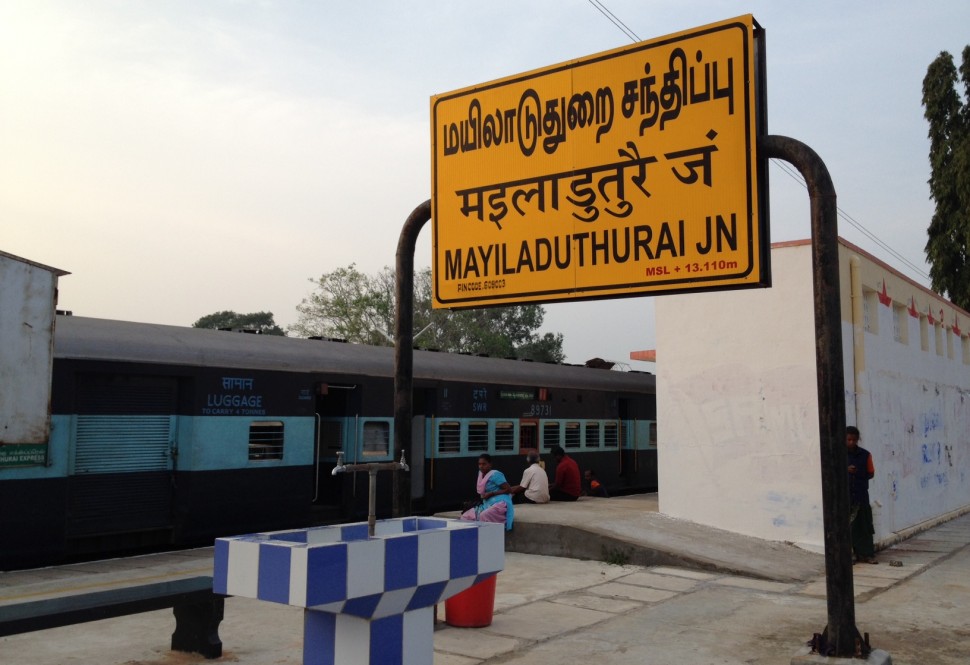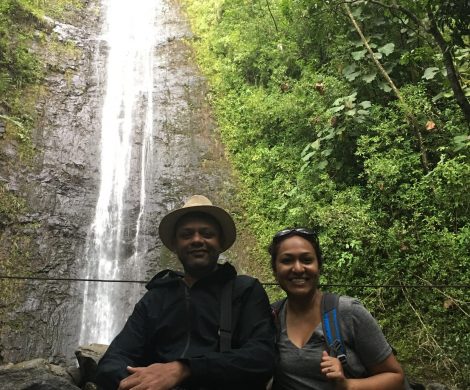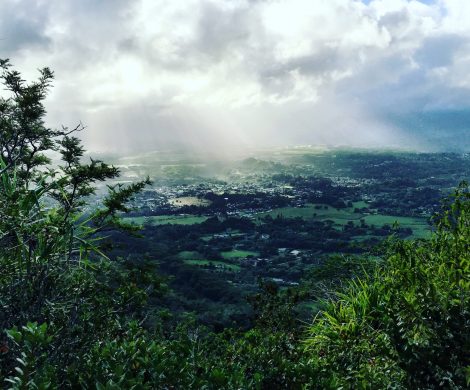
Deep in the heart of Tanjore district is the town of Mayiladuthurai, formerly known as Mayavaram or Mayuram. Growing up, I had often heard the name of this town and had a vague idea that my father’s family came from there. Except for the rare reference to Mayavaram at family weddings, the place didn’t mean anything to me.
A few years ago, my aunt who lives in the US, posted an album of photographs from her visit to India and this included a shot of a faded, moth-eaten photograph of two young men in a chipped wooden frame on a wall. One of these young men was my father, the other his younger brother. The picture was probably taken in the late 60s….at least 50 years old. The wall was in an old village house in a tiny, bylane called Pasupathy Agraharam in Mayavaram.
That got me curious. As far as I knew, no one in the family remained in Mayavaram anymore. So what was this photograph doing there? Turns out, the house once belonged to my great-grandmother Gowriamma and her brother, who was a well-known veterinarian in Mayavaram and this is the house that my father and his brother grew up in. The house no longer belongs to anyone in the family but the current occupants knew all about the legend of the two brothers who were brought to live with their grandmother due to extenuating circumstances, and who went on to overcome the limitations of their early life to make successful lives for themselves. The photograph held a place of pride in that house as these boys were known as the ‘Heroes of Pasupathy Agraharam‘ and the occupants refused to part with the picture when my aunt asked for it.
I was fascinated. Clearly, Mayavaram was an important part of my father’s history and I now wanted to know why. But it took another two years and a visit from my father to Malaysia, where I was living at the time, before I got closer to the story. He casually mentioned his plans to visit Mayavaram with my mother in a few months and did I want to join in?
OF COURSE, I WANTED TO JOIN IN!
This was my one opportunity to know more of the family history and where my dad really comes from. All I knew was that he’d had a hard life. He rarely ever spoke about his youth. From short conversations over the years, I knew that at one point, he lived in a mud hut with no electricity, walked long distances to his school and college because there was no money for bus fare, and if not for his brilliant academic record and mentoring by a professor at college, his life would have taken a very different course.
I was excited and yet nervous about this journey. I am a product of urban living and over the years have become accustomed to my creature comforts. Getting to Mayavaram required a 12-hour train journey from Bangalore and I hadn’t been in an Indian train for over a decade! And in a small town, hotels are at best 2-star rated! At the risk of sounding like a complete douche, this was playing at the back of my head as I boarded my flight from Kuala Lumpur to Bangalore. But, I am proud to report that I behaved myself and was suitably impressed to discover that the train had power sockets to charge mobile phones.
But this journey is not about my attempt at the simple life. It’s about the discovery of my roots and understanding the series of events and circumstances that led to my being born in an environment vastly different from my father’s and having the opportunities that he never had.
On this journey, I learnt so much more than I had bargained for. As we stepped off the train onto the Mayiladuthurai Station, it was like entering a different era. Time came to a standstill here a few decades ago.
First stop – Gurumurthy Vidyalaya
My dad wanted to know if the primary school he studied in still existed. So, we drove and drove around landmarks faded in his memory and roads and buildings that didn’t exist in his time and asked around till someone pointed us towards a road and asked us to take a left. As the car turned left, there it was, a signboard for the Gurumurthy Naduthilai Palli (middle school).

My dad was very sure the school would be long gone. He remembers it as a small, dilapidated govt run school back in the ’50s with one classroom where all the kids sat on the floor. The dilapidated structure still stands, though there are newer additions, an extended yard and a yellow school bus. Unfortunately, the school was closed, it being a Saturday and we couldn’t take a look inside.
From here, my dad told us, Pasupathy Agraharam was walking distance. But the once mud road is now laid with tar, and houses and newer structures have mushroomed along the way. Obviously, whatever shortcut he took to get to school 60 years ago, no longer exists! So, we got back into the car and decided to find the elusive Pasupathy Agraharam where his old schoolmate and neighbour Mr.Krishnamurthy, still lives!
Second Stop: Pasupathy Agraharam
Once again, we drove slowly past the area as my dad pointed out familiar places and recalled incidents from back in the day. Suddenly, we entered this really tiny, narrow lane, off the main road that connected to a parallel road and on this tiny lane stood an old man clearly waiting for someone. My dad has not seen Mr.Krishnamurthy since 1975, when he last visited Mayavaram with his new bride. It was my mother who suddenly said, “Isn’t that Mr.Krishnamurthy?” It was! My mother had seen him once, in 1975 and she was able to recognise him, while my father looked on doubtfully!

Pasupathy Agraharam had transformed drastically. It was no longer a random collection of tiny houses on a muddy path. During my father’s time, he doesn’t recall more than 15 or so houses there. Today, many of the old houses continue to stand, side by side with newer, more modern houses along a tar road that has been extended further. There are compound walls around all the houses and motorbikes dotting the lane. The Pasupathy temple itself was in the process of undergoing a transformation when we visited. As can be seen in the picture above, it’s just a tiny shed with a sloping roof. But this is being renovated now and the deity has been temporarily moved to a hut nearby.
Note: Agraharam is the name given to the Brahmin Quarter of a heterogenous village or to any village inhabited by Brahmins. Agraharams have lines of houses on either side of the road and the temple to the village god at the centre, thus resembling a garland around the temple.

Gowriamma’s house, probably built in the early 1900s, or possibly earlier, still stands and has been bought over by my dad’s childhood friend Mr.Rajendran’s family, who lives across the road. This is what I was most excited about…probably even more than my dad. It was hard to imagine him as a little boy growing up in this old house, surrounded by rice fields at one time.


Top right: the traditional grinding stone used for making dosa and idli batter. This has survived from Gowriamma’s time.
Bottom right: The storage room where all the knick knacks and treasured items would be stored
Bottom left: All the old village houses have this space for a lamp, known as the Ahal Villakku at the entrance to the living area.
While it looks ancient and crumbling, till a few months ago it was occupied by tenants, the same ones who had refused to part with the old photograph when my aunt asked for it. The photo now hangs in Mr.Rajendran’s house.

Third stop: Swimming Pool!
My dad and his friends then took us down the road to where they used to go swimming as boys. Gowriamma would shoo the boys off with a towel and tell them to get cleaned up. So they would go to the main road and jump off the bridge into the flowing river below. While the ledge from where they jumped off still exists, sadly the part of the river they jumped into is filthy with floating garbage. But the pond next to it looks relatively cleaner and this is where the boys learnt how to swim. I am not sure if anyone swims here anymore, though. When we were there, we found these ladies washing clothes by the steps.

Fourth Stop: Temple
Later that evening, we visited the 1000+ year old Mayuranathar temple, believed to have been built by the Medieval Chola kings, from which the town derives its name. My dad remembers walking to the temple with his uncle and grandmother, all the way from Pasupathy Agraharam. Today, walking on these roads would be impossible with the flow of traffic in these narrow roads.

Final Stop: Dinner
My dad was super excited about taking us to dinner at the Kaliyagudi hotel in the centre of town, which has been around since his time in Mayavaram. Apparently, it’s famous for its mouthwatering array of dishes and there is always a long queue to get in. Back in the day, it belonged to Mr.Sambasiva Iyer whose daughter Rukmini went to school with my dad in Grade 5. Ownership changed hands years ago, but the hype around the food was definitely worth it. Despite the waiting and the queuing, I can safely say, the softest, fluffiest idlis I have ever eaten in my life were at the Kaliyagudi hotel.

My dad left Mayavaram when he was around 15, for Madras, where I found out during this trip, challenging times awaited him. The cruel twist of fate that left his father, my granddad, a cripple. That led to the mud hut, the lack of bus fare, and the arrival of his paternal grandma Lakshmi Paati into his life as his guardian angel. That’s an entirely different story. His brother stayed on in Mayavaram till he completed his college education at a nearby town.
Their friends Krishnamurthy and Rajendran have continued to live in Pasupathy Agraharam. They recounted stories from the old days, when the 2 brothers led the gang of boys and tutored them in Math and Science and taught them to play cricket. Mr.Rajendran told me how he decided to study Chemistry for his Bachelor’s degree because my father took Chemistry before him and he had no one else to guide him. This led him to influencing his son and his nephew to take Chemistry as well and now he has an extended family of Chemistry graduates all thanks to a chain reaction started by my dad.
I can’t help but wonder how my father’s life would have turned out if he had stayed on in Mayavaram. Or mine for that matter. This journey to discover my roots has helped me better understand where I come from and the trials and tribulations that led to shaping the life I was born into.
Visiting a century old house that was once the home of my ancestors has been both humbling and enlightening. I’ll never know Gowriamma, but I am grateful for having got a glimpse into the household she ran, and where she sheltered two young boys who had nowhere else to go.
The #journey2roots travelogue will continue in Part 2.




[…] (Part 1 of #journey2roots here.) […]